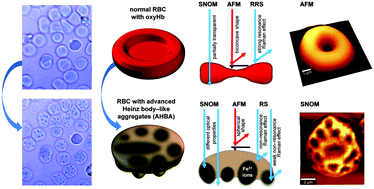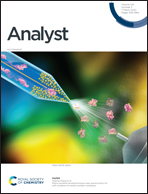Multimodal detection and analysis of a new type of advanced Heinz body-like aggregate (AHBA) and cytoskeleton deformation in human RBCs†
Abstract
A new type of aggregate, formed in human red blood cells (RBCs) in response to glutaraldehyde treatment, was discovered and analyzed with the classical and advanced biomolecular imaging techniques. Advanced Heinz body-like aggregates (AHBA) formed in a single human RBC are characterized by a higher level of hemoglobin (Hb) degradation compared to typical Heinz bodies, which consist of hemichromes. The complete destruction of the porphyrin structure of Hb and the aggregation of the degraded proteins in the presence of Fe3+ ions are observed. The presence of such aggregated, highly degraded proteins inside RBCs, without cell membrane destruction, has been never reported before. For the first time the spatial differentiation of two kinds of protein mixtures inside a single RBC, with different phenylalanine (Phe) conformations, is visualized. The non-resonant Raman spectra of altered RBCs with AHBA are characterized by the presence of a strong band located at 1037 cm−1, which confirms that glutaraldehyde interacts strongly with Phe. The shape-shifting of RBCs from a biconcave disk to a spherical structure and sinking of AHBA to the bottom of the cell are observed. Results reveal that the presence of AHBA should be considered when fixing RBCs and indicate the analytical potential of Raman spectroscopy, atomic force microscopy and scanning near-field optical microscopy in AHBA detection and analysis.



 Please wait while we load your content...
Please wait while we load your content...